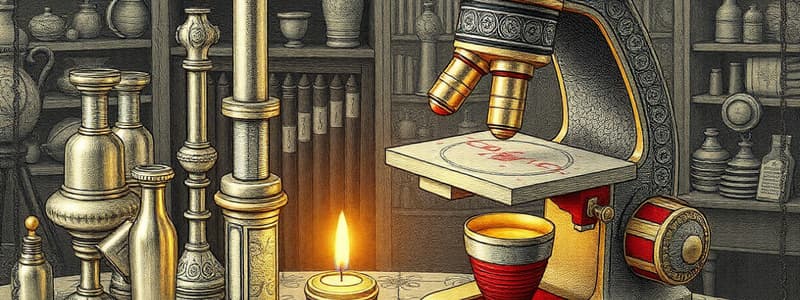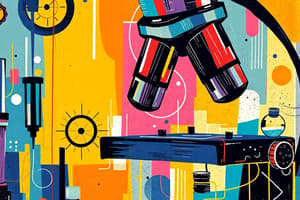Podcast
Questions and Answers
Which component of the microscope is primarily responsible for adjusting the brightness of the specimen's illumination?
Which component of the microscope is primarily responsible for adjusting the brightness of the specimen's illumination?
- Illuminator (correct)
- Stage
- Eyepiece
- Condenser
What is the purpose of the coarse focus mechanism on a microscope?
What is the purpose of the coarse focus mechanism on a microscope?
- To provide initial focus adjustments (correct)
- To make fine adjustments to the focus
- To hold the slide in place on the stage
- To illuminate the specimen more effectively
Which of the following is NOT a recommended method for cleaning microscope optics?
Which of the following is NOT a recommended method for cleaning microscope optics?
- Avoiding direct finger contact
- Using lens paper
- Using a microfiber cloth
- Using rough materials (correct)
What should be done if the microscope produces a blurry image?
What should be done if the microscope produces a blurry image?
When storing a microscope, what is the most important practice to prevent damage?
When storing a microscope, what is the most important practice to prevent damage?
If the stage of the microscope is unstable, which action should be taken first?
If the stage of the microscope is unstable, which action should be taken first?
In order to enhance image contrast, which microscope component can be adjusted?
In order to enhance image contrast, which microscope component can be adjusted?
What is the primary role of the rotatable nosepiece in a microscope?
What is the primary role of the rotatable nosepiece in a microscope?
Flashcards are hidden until you start studying
Study Notes
Microscope Components
-
Eyepiece (Ocular Lens):
- Often 10x or 15x magnification.
- Used to view the specimen.
-
Objective Lenses:
- Multiple lenses with varying magnifications (e.g., 4x, 10x, 40x, 100x).
- Rotatable nosepiece allows changing between objectives.
-
Stage:
- Platform where the slide is placed.
- May have clips to hold the slide in place.
-
Illuminator:
- Light source (bulb or mirror) used to illuminate the specimen.
- Adjusts brightness for optimal viewing.
-
Condenser:
- Focuses light onto the specimen.
- Often adjustable to enhance image contrast.
-
Focus Mechanisms:
- Coarse Focus: For initial focus adjustment, moving the stage significantly.
- Fine Focus: For precise focusing, allows small adjustments.
-
Base and Arm:
- Base: Supports the microscope.
- Arm: Connects the head to the base and is used for carrying.
Microscope Care
-
Cleaning:
- Use lens paper or microfiber cloth for optics.
- Avoid using rough materials that can scratch lenses.
-
Storage:
- Keep the microscope covered with a dust cover when not in use.
- Store in a stable, dry environment to prevent damage.
-
Handling:
- Always carry the microscope with two hands (one on the arm, one on the base).
- Avoid touching the lenses with fingers to prevent smudging.
-
Routine Maintenance:
- Regularly check and tighten screws, ensure all parts are functioning.
- Inspect the light source and replace bulbs as needed.
Troubleshooting
-
Blurry Image:
- Check if the microscope is properly focused.
- Ensure that the correct objective lens is being used.
-
Dim Illumination:
- Adjust the illuminator brightness.
- Verify that the light source is functioning and replace if necessary.
-
Dirty Lenses:
- Clean the objective and eyepiece lenses carefully.
- Ensure no dust or fingerprints are on the glass.
-
Unstable Stage:
- Check for loose screws or parts.
- Ensure the microscope is on a flat, stable surface.
-
Slide Issues:
- Ensure the slide is properly positioned on the stage.
- Use clips to secure the slide if it’s slipping.
Microscope Components
- Eyepiece (Ocular Lens): Magnifies the specimen with common options being 10x or 15x.
- Objective Lenses: Features multiple magnification levels, typically ranging from 4x to 100x, and are mounted on a rotatable nosepiece for easy switching.
- Stage: The area where slides are placed for examination; may include clips to secure slides during observation.
- Illuminator: Provides light through a bulb or mirror to enhance visibility of the specimen and includes brightness adjustment features.
- Condenser: Focuses light on the specimen, often adjustable to improve image contrast for clearer viewing.
- Focus Mechanisms:
- Coarse Focus: Used for major adjustments in focus, allowing significant movement of the stage.
- Fine Focus: Offers precision adjustments for detailed focusing on the specimen.
- Base and Arm:
- Base: Provides stability and support for the entire microscope.
- Arm: Connects the microscope body to the base and serves as a handle for transport.
Microscope Care
- Cleaning: Use lens paper or microfiber cloth to clean optics; avoid abrasive materials that may scratch surfaces.
- Storage: Keep the microscope covered with a dust cover when not in use, and store it in a stable, dry environment to avoid damage.
- Handling: Always use two hands when carrying the microscope—one on the arm and the other on the base—to maintain balance and prevent drops.
- Routine Maintenance: Regularly inspect all components for functionality, tighten screws as necessary, and check the light source, replacing bulbs if required.
Troubleshooting
- Blurry Image: Ensure proper focus adjustment and confirm the appropriate objective lens is selected.
- Dim Illumination: Adjust the brightness of the illuminator and check the functionality of the light source, replacing bulbs if needed.
- Dirty Lenses: Carefully clean the objective and eyepiece lenses to remove dust and fingerprints.
- Unstable Stage: Look for loose screws or parts and confirm the microscope is positioned on a flat, stable surface.
- Slide Issues: Verify correct slide placement on the stage and utilize clips to secure any slipping slides.
Studying That Suits You
Use AI to generate personalized quizzes and flashcards to suit your learning preferences.




